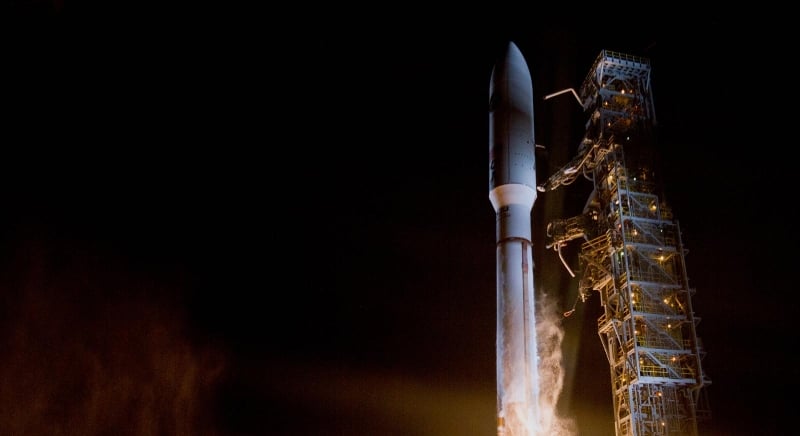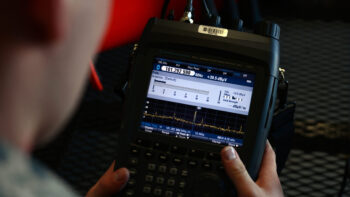 WASHINGTON: For the first time, Space Command is working with the operator and builder of America’s spy satellites, the NRO, to develop a shared “playbook” of pre-agreed actions to defend military and spy satellites during a conflict, SPACECOM and NRO officials say. The ‘playbook’ is a central part of a new joint concept of operations (CONOP) being hammered out by the two sides.
WASHINGTON: For the first time, Space Command is working with the operator and builder of America’s spy satellites, the NRO, to develop a shared “playbook” of pre-agreed actions to defend military and spy satellites during a conflict, SPACECOM and NRO officials say. The ‘playbook’ is a central part of a new joint concept of operations (CONOP) being hammered out by the two sides.
While the ‘playbook’ forms a baseline for planning, specific operations naturally would be dependent on the scenario unfolding in a battle — and the details of course are classified.
“The operational portion of the Concept of Operations, or CONOPS, is a joint effort between the NRO and U.S. Space Command (USSPACECOM) to strengthen and synchronize our defensive operations,” Maj. Gen. Michael Guetlein, the National Reconnaissance Office’s deputy director, told Breaking Defense in an email.
Further, he added, “specific actions may come from any domain.”
“The CONOPS will enable a synchronized approach to defensive space operations that will strengthen U.S. freedom of action in space. Specific actions may come from any domain and will be based upon a jointly-developed ‘playbook’ and informed by wargames and exercises,” a SPACECOM spokeperson elaborated in an email response.
The bottom line issue for the new joint operational concept, as Guetlein told the Mitchell Institute on April 24, is figuring out “who has the responsibility for defending which elements of the space enterprise and how?”
Once codified, the joint CONOP also will guide future Intelligence Community and Space Force acquisition, explained Guetlein in his email.
“The analysis is a partnership between the NRO, the Office of the Director of National Intelligence (ODNI) and the U.S. Space Force in order to define the ‘protect and defend’ architecture, establish responsibilities, and inform future investment priorities,” Guetlein said.
As Breaking D readers know, one of the critical acquisition issues is how to ensure assets designed, built, and operated by the NRO — which must meet both IC and DoD requirements sets that sometimes are very different — are linked into the military’s developing Joint All-Domain Command and Control (JADC2) system.
That acquisition debate has rekindled the long-simmering issue of NRO’s independence, especially in light of the standup of both the Space Force which will organize, train and equip space operators) and SPACECOM (the operational combatant command.) Indeed, Air Force leaders are still sorting through how to organize space acquisition authority given the fact that the Space Force is a co-equal service within the Department of the Air Force.
As a move toward better aligning requirements, NRO and the Space Force are jointly developing SILENT BARKER, a classified situational awareness satellite system, slated for launch in 2022. (The launch vehicle for the system was awarded to United Launch Alliance in February 2019.)
“SILENT BARKER is a space-based space situational awareness system that is a major component of an integrated Space Domain Awareness architecture working in concert with the U.S. Space Force’s ground-based assets. Working together, our two organizations are building a capability that meets both of our Indications and Warning needs without duplicating effort, and I’m excited to see what the future holds for this system,” Guetlein said.
NRO and SPACECOM also already work together operationally via the National Space Defense Center, which for SPACECOM falls under the new-ish Joint Task Force-Space Defense stood up last August by Gen. Jay Raymond. As a first step in a new operational concept, the two sides at the time reached an agreement that would see SPACECOM issue orders for protective movement of NRO’s satellites if they came under attack (although, as I reported last month, that does not mean taking over operational control of tasking NRO satellites.
“While we’re codifying the relationship in the CONOPS, the USSPACECOM and the NRO are already executing this relationship at the jointly-established and USSPACECOM led (through the Joint Task Force-Space Defense or JTF-SD) National Space Defense Center (NSDC) where our teams, along with representatives from across the Intelligence Community share information, plan together, train together, exercise together, and are in lockstep in being prepared to protect and defense U.S. space assets,” the SPACECOM spokesperson said.
The NSDC was created in 2017 by Strategic Command (STRACOM), which at the time was responsible for space operations, as beefed-up follow-on to the Joint Interagency Combined Space Operations Center (JICSpOC) in order to further tighten the relationship between “black” and “white” space. The highly classified JICSpOC, located at Schriever AFB in Colorado, was created in 2015 to help ensure integration and alignment of NRO, STRATCOM, and then-Air Force Space Command to clarify roles in space battle management.
The two sides further partner in wargames, which will serve as feedback mechanisms for the new CONOP.
“We, alongside our partner at USSPACECOM, are leveraging exercises like the Schriever Wargames, the recent Globally Integrated Exercise, and other exercises to validate and improve our planning process and shared defensive action ‘playbook’ to preserve our assured access to space,” Guetlein said.
As Breaking D readers know, the Globally Integrated Exercise concept is the brain child of former Chairman of the Joint Chiefs of Staff Joe Dunford, and has been taken up in earnest by current Chairman Gen. Mark Milley as part of an overarching rethink of the combatant command structure for future all-domain operations.
“We constantly leverage exercises like Global Lightning and Global Thunder and wargames, like the Schriever Wargame to synchronize and improve planning process and executing the space mission. Additionally, Thor’s Hammer, an NRO wargame that our JTF-SD participates in, is more of a strategic level wargame designed to foster the interaction between NRO, the Command and the warfighter,” the SPACECOM spokesperson added.






















